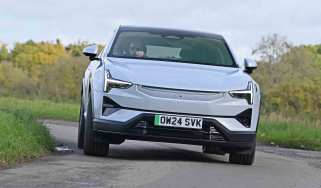Mazda CX-30 review - Engines, performance and drive
Engaging handling helps set the CX-30 apart from rivals, but the petrol-only lineup lacks variety

As mentioned previously, the CX-30’s driving experience is impressive. Few SUVs approach how well-judged the Mazda’s pedals, steering and gear shift are. Ensuring these key touchpoints are a pleasure to use helps make the CX-30 enjoyable, regardless of speed.
Mazda’s engineers have also done a good job of ensuring body roll is kept in check – which means it is easy to judge when the tyres reach their limit. That said, those prioritising keen handling might be better served by a Mazda 3 as it promises even less body roll (helped by being much closer to the ground).
Even so, the CX-30 comes with the same core benefits as its lower-riding stablemate; chief of which is a competent chassis. Compared to a Volkswagen T-Roc, the CX-30 is more compliant but it does sometimes struggle to dampen higher-frequency small bumps. At lower speeds this can result in vibrations being transmitted into the cabin.
In general, we’d stick with the brilliant six-speed manual gearbox thanks to its crisp shift. Automatic models are fine most of the time, but on hilly roads the auto ‘box tends to keep the engine towards the top end of its rev range, somewhat spoiling the impressive refinement.
Used - available now

2022 Mazda
Cx-30
24,161 milesManualPetrol2.0L
Cash £15,583
2022 Mazda
Cx-30
59,027 milesManualPetrol2.0L
Cash £12,500
2022 Mazda
Cx-30
26,706 milesManualPetrol2.0L
Cash £14,900
2020 Mazda
Cx-30
38,982 milesManualPetrol2.0L
Cash £15,600As standard, all CX-30 models get Mazda’s G-Vectoring Control Plus system, which, in layman's terms, limits how much torque is sent to the wheels to help with the transfer of weight while driving. As a system, it works well, even if it is quite subtle. Drivers stand the most chance of noticing it on slippery road surfaces.
Arguably, the CX-30’s most impressive piece of engineering is the Skyactiv-X engine. This uses the Japanese carmaker’s pioneering spark-controlled compression ignition technology. Put simply, Mazda has combined fuel-saving technology from diesel-engines with the kind of performance and refinement petrol cars are known for.
Skyactiv-G engines aren’t left out of the tech-fest, though. These come with cylinder deactivation technology which is designed to reduce fuel consumption and cut emissions.
0-62mph acceleration and top speed
The CX-30’s engine range is made up of two 2.0-litre naturally aspirated petrol engines – the SkyActiv-G and the Skyactiv-X – that both feature a mild-hybrid system. The former lacks sparkle thanks to producing just 120bhp and 213Nm of torque.
Numbers like these mean 0-62mph takes 10.6 seconds, with a manual gearbox, and 11.2 seconds with an automatic. Regardless of transmission, CX-30s with a SkyActiv-G engine have a top speed of 116mph. Also, all ‘G models are front-wheel drive only.
The more powerful Skyactiv-X unit is claimed to produce 183bhp and 240Nm of torque. It is also available with two- or four-wheel drive. Those that send power to the front wheels can only sprint from 0-62mph in 8.3 seconds (with a manual gearbox) and 8.6 seconds (with an auto ‘box).
All-wheel drive models are slightly slower, promising a 8.8-second 0-62mph time for manuals and a 9.0-second time for autos. Regardless of gearbox or drivetrain, Skyactiv-X variants have a top speed of 127mph.
While these figures are comparable with rivals such as the Skoda Karoq, the nature of Mazda’s naturally aspirated engines mean they have to be worked harder to get at the performance – partly due to a lack of low-down torque.











